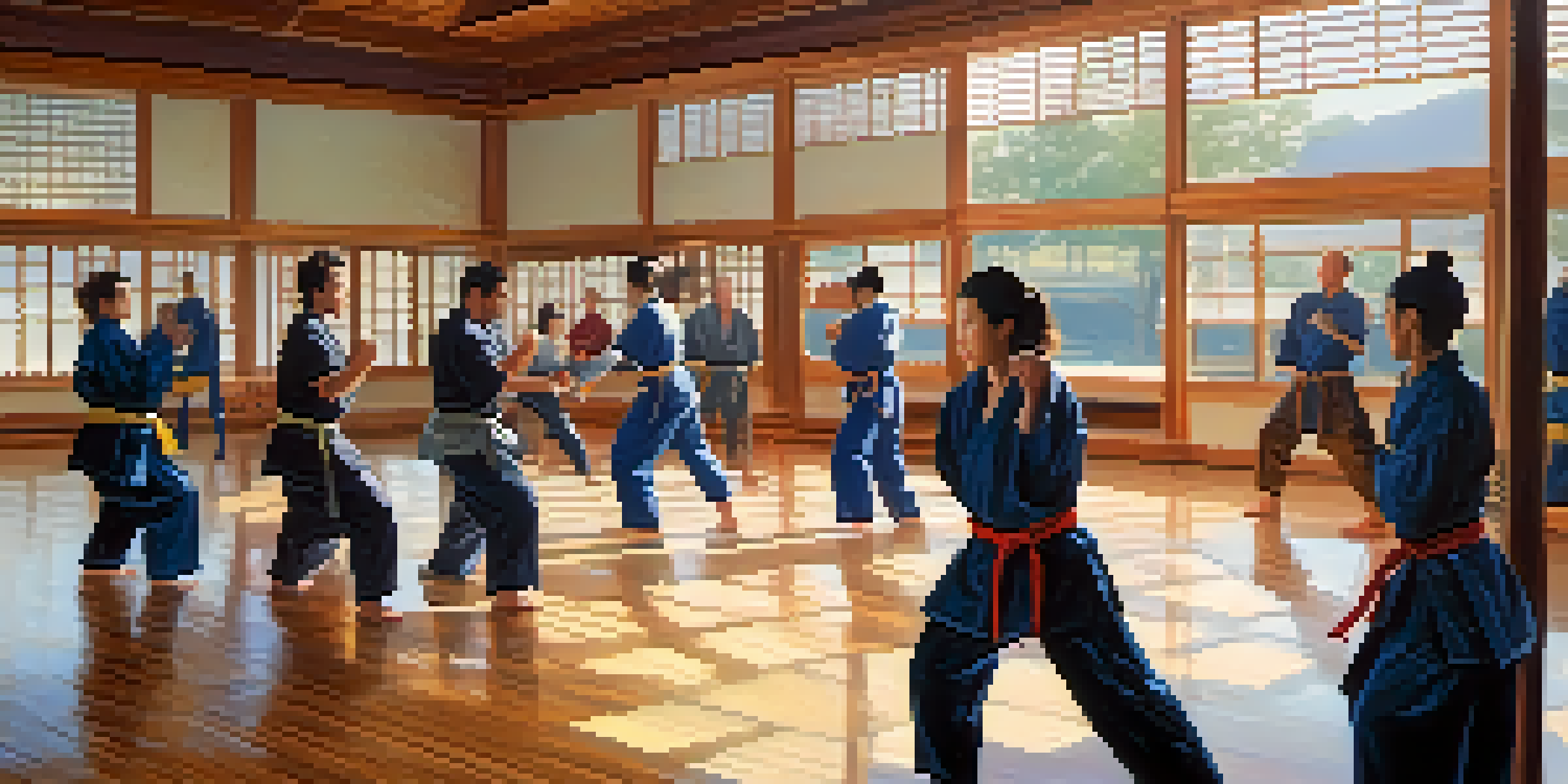Integrating Nonviolent Communication into Self Defense Training

Understanding Nonviolent Communication in Context
Nonviolent Communication (NVC) is a communication process developed by Marshall Rosenberg that focuses on empathetic dialogue. At its core, NVC emphasizes understanding needs and feelings without judgment or blame. This approach can create a safer environment for both trainers and trainees, encouraging open discussion about feelings and conflicts.
The greatest gift you can give another is the purity of your attention.
Incorporating NVC into self-defense training means recognizing not only the physical aspects of defense but also the emotional components of conflict. This perspective helps individuals understand their own triggers and reactions to fear or aggression. Rather than solely preparing for physical confrontations, trainees can cultivate emotional resilience and awareness.
By blending physical skills with emotional intelligence, self-defense training becomes a holistic practice. Participants learn not just how to defend themselves physically, but also how to navigate challenging interactions verbally. This can lead to more effective conflict resolution and ultimately, fewer physical confrontations.
Building Empathy Through Self-Defense Training
Empathy is a cornerstone of Nonviolent Communication, and it plays a crucial role in self-defense training. When individuals practice empathy, they develop a greater understanding of others' perspectives, which can diffuse potentially violent situations. This understanding can help trainees respond to threats with calmness rather than aggression.

Training that incorporates empathy allows participants to envision themselves in the shoes of an aggressor, enhancing their ability to de-escalate confrontations. It encourages them to ask questions like, 'What might this person be feeling?' or 'What do they need right now?' This shift in perspective not only fosters compassion but also prepares individuals to handle real-life situations more effectively.
NVC Enhances Self-Defense Training
Integrating Nonviolent Communication into self-defense training fosters emotional awareness and effective conflict resolution.
By integrating empathy into self-defense, trainers empower individuals to become not just defenders but peacemakers. This approach transforms the traditional view of a self-defense practitioner from a combative fighter to a thoughtful communicator. Ultimately, this can lead to a safer community as individuals learn to prioritize understanding over fighting.
The Role of Active Listening in Conflict Scenarios
Active listening is a key skill in Nonviolent Communication that can be invaluable in self-defense situations. It involves fully concentrating on what is being said rather than just passively hearing the message. In a potentially threatening situation, practicing active listening can help individuals assess the intent and emotions of others, leading to more informed responses.
Peace cannot be kept by force; it can only be achieved by understanding.
Incorporating active listening into self-defense training means creating exercises where participants must listen carefully to others' concerns or threats. This practice helps trainees respond thoughtfully rather than react impulsively. By fostering an environment where listening is prioritized, individuals can better navigate conflicts with clarity.
Moreover, active listening builds trust and rapport, which can be crucial in de-escalating volatile situations. When individuals feel heard, they are often more willing to engage in constructive dialogue. This skill not only enhances personal safety but also contributes to building stronger, more compassionate communities.
Expressing Needs and Feelings Effectively
A fundamental aspect of Nonviolent Communication is the ability to express one's needs and feelings effectively. In self-defense training, being able to articulate what one requires in a given situation can prevent misunderstandings and conflict escalation. Teaching trainees to identify and communicate their needs fosters a proactive approach to potential threats.
For instance, during role-playing scenarios, trainers can encourage participants to express their feelings and needs clearly, such as saying, 'I feel threatened when you come too close, and I need space.' This practice not only empowers individuals to stand their ground but also promotes mutual respect in interactions.
Empathy Diffuses Violent Situations
Practicing empathy allows trainees to understand threats better, enabling them to respond calmly rather than with aggression.
As trainees become more adept at expressing their feelings and needs, they gain confidence in their ability to handle difficult situations. This skill can lead to more assertive and peaceful interactions, reducing the likelihood of physical confrontations. In essence, effective communication becomes a powerful tool in self-defense.
Creating a Safe Space for Practice and Growth
Integrating Nonviolent Communication into self-defense training requires creating a safe space for practice and growth. A supportive environment encourages participants to explore their feelings and learn from mistakes without fear of judgment. This safety is crucial for building trust among trainees and instructors, fostering a richer learning experience.
In such a space, participants can engage in open discussions about their fears and experiences related to violence. This dialogue can lead to deeper insights and shared learning, as individuals find common ground in their experiences. It also allows for the exploration of alternative conflict resolution strategies, further enhancing the training.
When trainees feel safe to express themselves, they are more likely to absorb the lessons of Nonviolent Communication. This supportive framework not only improves self-defense skills but also nurtures personal development. As a result, participants leave the training not just as better defenders but as more empathetic individuals.
Practicing Nonviolent Communication Techniques
To truly benefit from Nonviolent Communication in self-defense training, participants need to practice specific techniques regularly. Role-playing scenarios that incorporate NVC principles allow trainees to experience the benefits firsthand. For instance, they can simulate a confrontation and practice expressing their needs while using empathetic listening.
Instructors can also introduce exercises that focus on identifying emotions and needs during practice sessions. This could involve using language that reflects feelings, such as 'I feel anxious when faced with aggression,' to help trainees articulate their experiences clearly. Regular practice reinforces these skills, making them second nature in real situations.
Active Listening Builds Trust
Active listening skills in self-defense training promote clearer communication and stronger community bonds, which can de-escalate conflicts.
As participants become comfortable with these techniques, they can adapt them to various contexts, both inside and outside the training environment. This adaptability not only enhances their self-defense capabilities but also enriches their interpersonal relationships. Ultimately, practicing NVC techniques empowers individuals to navigate life’s challenges with confidence and compassion.
The Long-Term Benefits of Integrating NVC in Self-Defense
Integrating Nonviolent Communication into self-defense training offers long-term benefits that extend far beyond physical skills. Participants often report increased self-awareness, emotional regulation, and improved relationships. These skills contribute to a sense of empowerment, allowing individuals to approach conflicts with a calm and collected mindset.
Over time, the practice of NVC can lead to a culture of peace within communities. As more individuals adopt these principles, the overall approach to conflict and confrontation shifts from aggression to understanding. This cultural change fosters safer environments where dialogue is prioritized over violence.

Finally, the emotional resilience developed through NVC can serve individuals well in various aspects of life. Whether in personal relationships, workplace dynamics, or community interactions, the skills learned in self-defense training can lead to more harmonious and cooperative relationships. This holistic approach ensures that participants leave not just as capable defenders but as advocates for nonviolence.